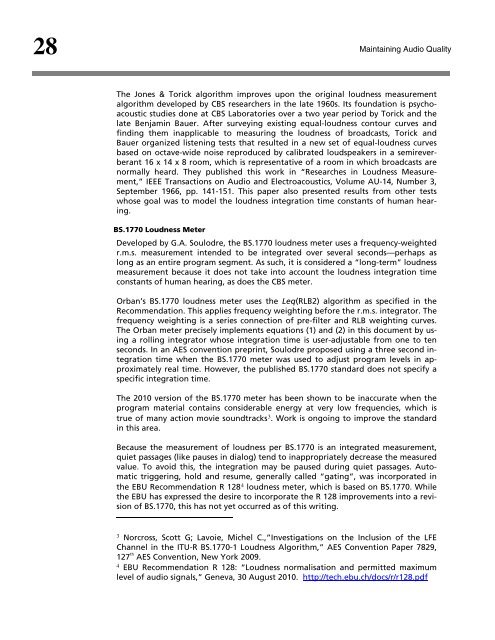Maintaining Audio Quality in the Broadcast Facility 2011 - Orban
Maintaining Audio Quality in the Broadcast Facility 2011 - Orban
Maintaining Audio Quality in the Broadcast Facility 2011 - Orban
You also want an ePaper? Increase the reach of your titles
YUMPU automatically turns print PDFs into web optimized ePapers that Google loves.
28<br />
<strong>Ma<strong>in</strong>ta<strong>in</strong><strong>in</strong>g</strong> <strong>Audio</strong> <strong>Quality</strong><br />
The Jones & Torick algorithm improves upon <strong>the</strong> orig<strong>in</strong>al loudness measurement<br />
algorithm developed by CBS researchers <strong>in</strong> <strong>the</strong> late 1960s. Its foundation is psychoacoustic<br />
studies done at CBS Laboratories over a two year period by Torick and <strong>the</strong><br />
late Benjam<strong>in</strong> Bauer. After survey<strong>in</strong>g exist<strong>in</strong>g equal-loudness contour curves and<br />
f<strong>in</strong>d<strong>in</strong>g <strong>the</strong>m <strong>in</strong>applicable to measur<strong>in</strong>g <strong>the</strong> loudness of broadcasts, Torick and<br />
Bauer organized listen<strong>in</strong>g tests that resulted <strong>in</strong> a new set of equal-loudness curves<br />
based on octave-wide noise reproduced by calibrated loudspeakers <strong>in</strong> a semireverberant<br />
16 x 14 x 8 room, which is representative of a room <strong>in</strong> which broadcasts are<br />
normally heard. They published this work <strong>in</strong> “Researches <strong>in</strong> Loudness Measurement,”<br />
IEEE Transactions on <strong>Audio</strong> and Electroacoustics, Volume AU-14, Number 3,<br />
September 1966, pp. 141-151. This paper also presented results from o<strong>the</strong>r tests<br />
whose goal was to model <strong>the</strong> loudness <strong>in</strong>tegration time constants of human hear<strong>in</strong>g.<br />
BS.1770 Loudness Meter<br />
Developed by G.A. Soulodre, <strong>the</strong> BS.1770 loudness meter uses a frequency-weighted<br />
r.m.s. measurement <strong>in</strong>tended to be <strong>in</strong>tegrated over several seconds—perhaps as<br />
long as an entire program segment. As such, it is considered a “long-term” loudness<br />
measurement because it does not take <strong>in</strong>to account <strong>the</strong> loudness <strong>in</strong>tegration time<br />
constants of human hear<strong>in</strong>g, as does <strong>the</strong> CBS meter.<br />
<strong>Orban</strong>’s BS.1770 loudness meter uses <strong>the</strong> Leq(RLB2) algorithm as specified <strong>in</strong> <strong>the</strong><br />
Recommendation. This applies frequency weight<strong>in</strong>g before <strong>the</strong> r.m.s. <strong>in</strong>tegrator. The<br />
frequency weight<strong>in</strong>g is a series connection of pre-filter and RLB weight<strong>in</strong>g curves.<br />
The <strong>Orban</strong> meter precisely implements equations (1) and (2) <strong>in</strong> this document by us<strong>in</strong>g<br />
a roll<strong>in</strong>g <strong>in</strong>tegrator whose <strong>in</strong>tegration time is user-adjustable from one to ten<br />
seconds. In an AES convention prepr<strong>in</strong>t, Soulodre proposed us<strong>in</strong>g a three second <strong>in</strong>tegration<br />
time when <strong>the</strong> BS.1770 meter was used to adjust program levels <strong>in</strong> approximately<br />
real time. However, <strong>the</strong> published BS.1770 standard does not specify a<br />
specific <strong>in</strong>tegration time.<br />
The 2010 version of <strong>the</strong> BS.1770 meter has been shown to be <strong>in</strong>accurate when <strong>the</strong><br />
program material conta<strong>in</strong>s considerable energy at very low frequencies, which is<br />
true of many action movie soundtracks 3 . Work is ongo<strong>in</strong>g to improve <strong>the</strong> standard<br />
<strong>in</strong> this area.<br />
Because <strong>the</strong> measurement of loudness per BS.1770 is an <strong>in</strong>tegrated measurement,<br />
quiet passages (like pauses <strong>in</strong> dialog) tend to <strong>in</strong>appropriately decrease <strong>the</strong> measured<br />
value. To avoid this, <strong>the</strong> <strong>in</strong>tegration may be paused dur<strong>in</strong>g quiet passages. Automatic<br />
trigger<strong>in</strong>g, hold and resume, generally called “gat<strong>in</strong>g”, was <strong>in</strong>corporated <strong>in</strong><br />
<strong>the</strong> EBU Recommendation R 128 4 loudness meter, which is based on BS.1770. While<br />
<strong>the</strong> EBU has expressed <strong>the</strong> desire to <strong>in</strong>corporate <strong>the</strong> R 128 improvements <strong>in</strong>to a revision<br />
of BS.1770, this has not yet occurred as of this writ<strong>in</strong>g.<br />
3 Norcross, Scott G; Lavoie, Michel C.,”Investigations on <strong>the</strong> Inclusion of <strong>the</strong> LFE<br />
Channel <strong>in</strong> <strong>the</strong> ITU-R BS.1770-1 Loudness Algorithm,” AES Convention Paper 7829,<br />
127 th<br />
AES Convention, New York 2009.<br />
4 EBU Recommendation R 128: “Loudness normalisation and permitted maximum<br />
level of audio signals,” Geneva, 30 August 2010. http://tech.ebu.ch/docs/r/r128.pdf



![[PDF] Using the ITU BS.1770-2 and CBS Loudness Meters ... - Orban](https://img.yumpu.com/50629372/1/190x245/pdf-using-the-itu-bs1770-2-and-cbs-loudness-meters-orban.jpg?quality=85)






![[PDF] Optimod-FM Feature Comparison - Orban](https://img.yumpu.com/41741615/1/190x245/pdf-optimod-fm-feature-comparison-orban.jpg?quality=85)






